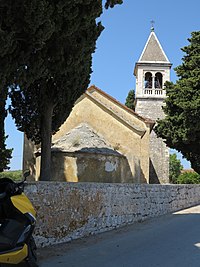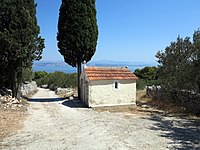Donje Selo (Šolta)
| Donje Selo | ||
|
|
||
| Basic data | ||
|---|---|---|
| State : |
|
|
| County : |
|
|
| Island : | Šolta | |
| Height : | 115 m. i. J. | |
| Residents : | 161 (2011) | |
| Telephone code : | (+385) 021 | |
| Postal code : | 21430 Grohote | |
| License plate : | ST | |
| Structure and administration (as of 2017) |
||
| Community type : | Village | |
| Mayor : | Nikola Cecić-Karuzić (candidate Grupe Birača) | |
| Postal address : | Podkuća 8 Grohote |
|
| Website : | ||
Donje Selo , the lower village , is a farming village on the island or municipality of Šolta in the Croatian Split-Dalmatia County in the Adriatic opposite Split west of Brač . Donje Selo belongs to Grohote and has 161 inhabitants.
Geography & Demography

Donje Selo, the lower village, is connected to the mainland ( Split ) by car ferries and catamaran ferries via Rogač or Stomorska . It is 2.9 km from the island's main town, Grohote . Buses to Donje Selo run from the Rogač ferry port. The surrounding area belongs to the place.
Donje Selo is located on the north-western edge of the fertile Donje polje field, the lower field . The upper field is that of Gornje Selo , where the richest farmers lived. The old road leads from the center of Donje Selo to Srednje Selo and on to Grohote. The state road D111 passes the towns in the south. A side road goes from the center of Donje Selo to the Donja Krušica bay to the north, the port belonging to the village.
economy
Donje Selo is a simple farming village with no tourism. Only in the port of the village, in Donja Krušica, there are six apartment providers. Farmers and fishermen live in the village. The area around Donje Selo is considered to be the best hunting area on the island in the hunting season.
history
A first written record dates from 1474 as a villa inferior . 100 years later, around 1579, the Croatian name Dognesello is used. The women of Donje Selo are called Dolivaška , which goes back to the Old Slavic or Croatian vas for village. The “upper place” was probably once called Srednje vas . At the time of the Austro-Hungarian monarchy , the place was listed in the administration until 1918 with the Italian name Villa Inf., Which is abbreviated for Villa Inferior .
As usual on Šolta, one can assume that the place was already settled in ancient times. Archaeological finds can be found in the corridors Bunje, Mirine and Studenac in the west and Pod Mihovil and Svilaja in the south. Remains of farm buildings, graves, fragments of architectural sculptures and ceramic shards are known. Many ancient finds from the island are exhibited in the Archaeological Museum in Split .
On the main path in the central island field on the site of an earlier villa rustica stands the chapel of St. Jele. The stone holy water kettle karstiak at the church entrance dates from 1746 and has the signatures of two local stonemasons. The building with a nave measuring 8.3 mx 5.7 m has a semicircular apse and stands on the foundation walls of an early Christian church. A sarcophagus from the 6th century serves as the altar , on which a triptych depicting the Assumption of Mary between Saints Dominic and Sebastian was placed around 100 years ago . To the right of the altarpiece is St. Helena of the Holy Cross and on the left St. Dujam ( Duje ), the patron saint of Split, which could have come from an early Baroque altarpiece. Helena was the mother of the Roman emperor Constantine , by whom she was appointed Augusta . She is venerated as a saint in the Catholic and Orthodox Churches . According to a local legend, it was believed to come from the neighboring island of Brač. Constantine's father, the Roman Caesar Constantius I, was governor of Dalmatia at the time of Emperor Diocletian with his headquarters in Salona . While on a hunt for Brač, Constantius had to spend the night in a shepherd's house (bunja) because he got lost. The shepherd's daughter had completely mended his torn cloak overnight, he fell in love with her and she became his wife.
The island of Šolta was owned by the Split nobility and the Catholic Church from the 14th century to 1905 . The proximity to Split made the island an important supplier of wood, lime, meat, fish, oil, wine, almonds, carob , figs and honey. The residents were not free farmers, but tenants of the land.
On the southern edge of the village, the cemetery church of St. Martin built. There was probably an early Christian basilica here. In 1902 the church was enlarged again and the neo-Renaissance bell tower was added. In the decades around 1900, many of the large buildings were reached as many emigrants sent money to their old homeland. The voluminous schoolhouse was built in 1928. In the 1930s, a former natural pond was replaced by a large cistern with a Volujak fountain and Svilaja water collection point . There is a sarcophagus lid nearby, which was used as a drinking trough for animals.
On the main square there is a war memorial of the People's Liberation Army by Josip Broz Tito from the time of the Communist People's Republic of Yugoslavia . Next to it the old brotherhood house of the Martin worshipers. A stylized “footprint of St. Martin “, a sign of the solidarity of the European followers of the Martinsult, which connects around 150 places in Europe. St. Martin came from the Pannonian Sabaria, today's Szombathely in Hungary. The house dates back to the 18th century and belonged to a family of blacksmiths from Bosnia. When the last family member Ivan Bosna (Mistro Juane Bosna da Spalato) died, the brotherhood of h. Martin the house. In the second half of the 19th century it served as a school house. From 1873 agricultural culture techniques were taught. Members of the brotherhood built a cistern in 1878. In 2009/2010 the house was restored by the Brotherhood and returned to its original state.
The typologically similar village to Grohote, whose roots go back to the Middle Ages, is located on the mountainside on the edge of the fertile plain. The houses stand close together, criss-crossed by winding streets. Ten families lived here in the 17th century and fourteen in the 19th century. Because of the danger of pirates, the courtyards were always enclosed by stone walls and apart from the main entrance on the ground floor they had no opening. Since Šolta was in the border area between the Ottoman Empire and the Republic of Venice , the danger of looting and raids, especially by the pirates of Omiš, was great, which is why there were only places in the interior of the island for centuries. However, there was no real protection without fortress towers. On the feast day of St. John the Baptist in 1669 the pirates from Ulcinj ravaged the village of Donje Selo and took 64 men with them as slaves . The most beautiful farms that have been preserved are those of the Blagaić, Begović, Lisičić and Kalebić-Vidošev families.
The houses and the shelter for fishing boats in Donja Krušica were built in the 18th century.
There is friendship and enmity with the neighboring village of Srednje Selo. The residents of Donje Selo were often teased that they were stupid because they would only marry each other.
Personalities
- Vjekoslav Blaškov (1912–1948), b. in Donje Selo, officer, politician and journalist
literature
- Joško Belamaric: Island of Šolta. (Library of Tourism and Heritage. No. 82). Zagreb 2011, ISBN 978-953-215-697-3 .
- Mladen Andreis: Stanovništvo otoka Šolte do godine 1900. Šolta, Opcina 2011, ISBN 978-953-55249-1-5 . [1]
Web links
- Općina Šolta: Šolta Općina Šolta. Retrieved on August 13, 2019 (Croatian, official website of the municipality of Šolta).
- Ferry times
Individual evidence
- ↑ Statistical yearbook for 2006 of the Central Bureau of Statistics of the Republic of Croatia (PDF file; 2.38 MB), accessed on May 21, 2017.
- ↑ Zoran Civadelic / Zoran Bursac: Welcome to Donja Krusica! accessed on May 21, 2017.
- ^ Belamaric: Island of Šolta. Zagreb 2011, p. 33.
- ↑ Stermich (Segretaria di Governo): AVVISO No. 24979-9466. In: Gazzetta di Zara / Gazzetta di Zara. Foglio Ufficiale (d'Annuncii / d'Annuzi) della Gazzetta di Zara , February 2, 1841, p. 12 (online at ANNO ). , accessed on September 3, 2019 (Italian, price list for cadastral extracts)
- ↑ Split Archaeological Museum | German
- ^ Belamaric: Island of Šolta. Zagreb 2011, p. 33 ff.
- ^ The Brotherhood of St Martin. Notice board on the building.
- ^ Belamarić: Island of Šolta. Zagreb 2011, p. 61.








